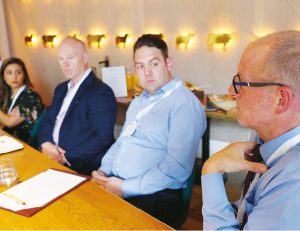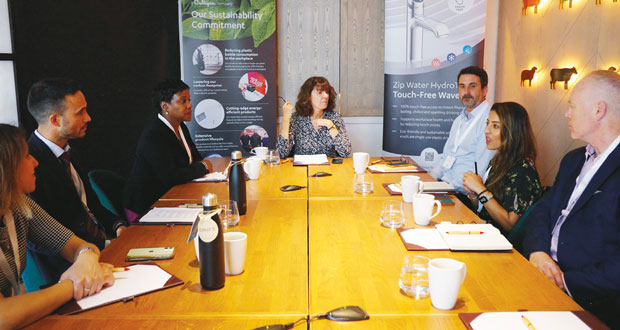Q: What role can technology play in helping to deliver a sustainable workplace?
Zip’s Ferguson reports: “What we saw during the pandemic was that people stopped talking about sustainability and focused on hygiene – so developing hands free was something we developed to bring to the market. As people have come back into the workplace it’s not wanted as much but it’s become something they’re now used to having.”
Hands free is no de rigueur for many organisations. “We carried out a study on the things you touched, which included handrails, lift buttons, so we invested in all the key things we could change, and as a result the toilets are now all hands free.”
Touch free is also linked to sustainability, so it prevents things like washroom taps being left running. Simi Gandhi-Whitaker revealed that Mitie has been doing a lot of data and analytics around cutting carbon by better monitoring of assets. “If FMs can prove that just looking at those assets you can adjust temperatures and BMS controls you can save energy. As FMs if we can give that data to our client organisations, it’s within our gift.”
Technology also extends to the adoption of apps for employees to encourage the adoption of healthier habits, from taking more steps to reminding them to drink more water.
Said Zip’s Johnson: “We’ve got future products coming which are going to tell people how many litres of water they’ve drunk which will help them monitor their own wellbeing without someone else reminding them. We also have a system in place to monitor the taps, which takes the onus off someone having to remember to check. This technology drive is coming across all industries and the more people feel a need for it, the more suppliers and FMs are going to have to gear their strategy towards it; so we need to deliver it, otherwise we’re not going to progress.”
Q: Does there need to be more investment by the C-suite in helping FMs achieve sustainable health and wellbeing?
Our panellists felt that their Boards were: “More focused than ever before on investing on the services that you provide for the wellbeing of the staff and service users – this does require a higher budget initially, but the long terms gains will be significant.”
However one of the panelists said: “Investment is required and when I think about what has been done across our facilities over the last two years – end of route facilities, wellbeing lounges, acoustic battens, biophilia – it all costs money, so you also need a strategy which helps you secure that investment and put positive changes in place.”
Another totally agreed, “In our organisation the senior management is very engaged in sustainability and wellbeing which makes our lives easier.”
As a supplier Johnson said: “Reinvestment is required but so is determining value added, because it isn’t what it was five years ago. Both the two go hand in hand, and if you don’t do the two together you won’t get the best outcome for your customers.”
FM’s still have some convincing to do said another of the client side FMs: “Our C-suite is saying all the right things but the task for property is working out what we’re going to do with our estate now and release funds from that to reinvest.”
 As a FM provider said Gandhi-Whitaker: “Investment is key, but it’s also having a clear strategy on what we are doing, what are the reasons and what are the perceived outcomes, and it is here that data and analytics give you the facts around whether you’re saving energy or getting people back into the workplace – so not just doing it for the sake of it.”
As a FM provider said Gandhi-Whitaker: “Investment is key, but it’s also having a clear strategy on what we are doing, what are the reasons and what are the perceived outcomes, and it is here that data and analytics give you the facts around whether you’re saving energy or getting people back into the workplace – so not just doing it for the sake of it.”
Concluding the discussion, Ian Baker of EMCOR summed up the challenge: “We know that 90 per cent of an organisation’s cost is people, so if you spend even a tiny amount in improving their performance and productivity that ROI speaks for itself and for me wellbeing is the one area that has to be the most authentic or everyone will see through it and think it’s a tick box exercise.”
To find out more about the roundtable event, including a video click here.





